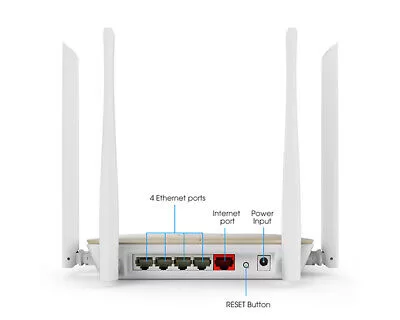Routers are essential networking devices that connect your business to the internet by forwarding data packets. They serve as the bridge between your local network and the vast world of the internet.
What is a router?
A device known as a router is one that can connect multiple packet-switched networks or subnetworks to one another. Its principal roles are to manage traffic between these networks by directing data packets to the IP addresses to which they are addressed and to enable several devices to share a single Internet connection.
There are many different kinds of routers, but the primary function of most routers is to transfer data between local area networks (LANs) and wide area networks (WANs). A local area network, or LAN, is a collection of interconnected devices that are confined to a single physical location. In most cases, a local area network will only need one router.
what does a router look like
A router usually has the appearance of a tiny, square- or rectangular-shaped electrical gadget. To show its connectivity and status, the front panel often contains many LED lights. Multiple ports on the router’s back allow you to connect different cables and devices. These ports could consist of:

- The WAN (Wide Area Network) port is where your internet service provider’s (ISP) internet cable is connected.
- LAN (Local Area Network) ports: You can use these ports to link connected devices to your local network, like printers, gaming consoles, and PCs.
- Antennas: External antennas on certain routers can be tilted to increase the range and power of the wireless signal.
- Power input: This is where the power adapter for the router is plugged in.
Routers might look different depending on their size and shape, but they usually have a design that allows for both wired and wireless connections, which helps to spread internet connectivity across your house or place of business.
what does a router do
A router is an important piece of networking equipment that controls and directs the flow of data in a computer network. These are the main things that a router does:
- Network Connection: A router links devices in a local area network (LAN) to the internet and to each other. As a link between your home or business network and your ISP, it works like a bridge.
- Routing: Routers use a routing table to figure out the best way for data bits to get from one device on the network to another on the internet. Based on the target IP address, they make smart choices about how to send the data.
- A firewall is a security shield that sits between your network and the internet. Many routers come with one built-in. It can either let or block incoming and outgoing data based on rules that you set. This helps keep your network safe from threats and people who aren’t supposed to be there.
- A network address translator (NAT) lets several devices on a private network share a single public IP address. It helps protect IPv4 addresses and adds security by keeping outsiders from seeing how the private network is set up.
- Connectivity over Wi-Fi: Many new routers come with built-in wireless access points that let devices connect to the network freely via Wi-Fi. People often call these routers “wireless routers.”
- Quality of Service (QoS): Routers can set priorities for network traffic to make sure that important data, like voice or video calls, gets the best service, making the experience faster and more reliable.
- Forwarding Ports: Routers can be set up to send new data packets to certain devices or services on the same local network. This is helpful for hosting servers, running games, or connecting to gadgets from afar.
- Routers often offer DHCP services that give IP addresses to network devices automatically, making it easier for users to set up their networks.
A router is an important networking device that controls the flow of information between devices in a network and the internet. It directs data traffic, keeps devices safe, allows Wi-Fi connections, and manages security. A big part of making sure that info gets where it needs to go quickly and safely is this.
How does a router work?
Routers manage and direct network traffic by routing packets containing information like files, phone calls, and web requests.
Each data packet has multiple sections, or layers, each of which contains the IP (Internet protocol) address of the intended recipient as well as other metadata about the sender, the data type, and the packet’s size. The router analyzes this layer to determine the transmission’s priority and the optimal path.
A router makes use of its own internal routing table, which is essentially a list of the different routes that can be taken to reach a variety of network destinations, in order to properly direct packets. The header of a packet is read by the router to establish where it is headed, and then the router checks the routing table to determine the quickest and most direct route to reach that destination. After that, it sends the packet onto the subsequent network along the route.
This process involves several key steps:
- Packet Reception: Routers receive incoming data packets from various devices on the network.
- Address Decoding: The router deciphers the destination address in the packet header.
- Routing Decision: Using complex algorithms, the router determines the optimal path for the data to travel.
- Forwarding: The data packet is sent to the next hop on its journey, often through a series of routers.
- Transmission: The packet travels along the selected path until it reaches its final destination.
Why Routers Matter
Routers are not just devices that enable internet access; they are the backbone of a smooth and efficient online experience for your business. Here are some key reasons why routers matter:
1. Fast and Reliable Internet
A high-quality router ensures fast and reliable internet connectivity for your business. With advanced technologies like dual-band and tri-band routers, you can enjoy faster and more stable connections, even with multiple devices connected simultaneously.
Whether you’re streaming videos, hosting video conferences, or conducting online transactions, a powerful router ensures that your internet connection remains stable and doesn’t slow down, enabling seamless business operations.
2. Seamless Network Integration
Routers play a crucial role in connecting various devices within your business network. With a router, you can effortlessly integrate Servers, computers, smartphones, printers, and other devices into a single network, enabling easy data sharing and collaboration.
By creating a unified network environment, routers enhance productivity and communication within your business. Employees can share files, access shared resources, and collaborate on projects effortlessly, leading to improved efficiency and streamlined operations.
Learn the Difference Between Switch and Router | Switch vs. Router
Components of a Router
To comprehend the inner workings of a router, let’s explore its key components:
- Central Processing Unit (CPU): The brain of the router that executes instructions and manages data flow.
- Memory: Stores routing tables, configurations, and operational data.
- Interfaces: Physical ports connecting the router to devices via Ethernet or wireless connections.
- Routing Table: A map of available paths that guides data through the network.
- Operating System: Software that controls router functionality and allows configuration.
Types of Routers
1. Wireless router
Home gateways, often known as wireless routers, perform the roles of both edge routers and distribution routers. These are typical routers used to connect homes to the Internet.
The majority of internet service providers include fully functional wireless routers with their packages. Even though your Internet service provider (ISP) offers a wireless router, a business-grade router may be preferable for a number of reasons, including improved wireless performance, more connectivity management, and increased security.
2. Distribution router
The edge router (or gateway) transfers data via a cable connection to an inner router, which then sends it to the end users via Wi-Fi. However, distribution routers also commonly have physical (Ethernet) connections for connecting users or additional routers.
3. Core router
Internet service providers (ISPs) and cloud providers (e.g., Google, Amazon, Microsoft) typically deploy core routers. They provide the highest possible data transfer rates when linking to other routers or switches. Core routers are unnecessary for most small organizations. However, core routers may be a part of the network architecture of very big organizations with numerous employees spread over a number of buildings or sites.
4. Edge router
An edge router, sometimes known as a gateway router or simply a “gateway,” is a network’s last point of contact with the outside world.
In order to deliver data to end users, edge routers are built with bandwidth in mind and are meant to link to other routers. Edge routers typically lack Wi-Fi and granular network administration features. They normally only have Ethernet connections, one to input data from another router and numerous to output data to the Internet.
Although the term “modem” is no longer generally used by manufacturers or IT experts when referring to edge routers, the two names are fairly equivalent.
5. Virtual router
Some router capabilities can be virtualized and offered as a service via the cloud thanks to the existence of virtual routers. Large companies with sophisticated network requirements can benefit greatly from these routers. They are more adaptable, simple to scale, and less expensive to implement. Local network hardware administration is simplified using virtual routers.
Choosing the Right Router
Now that you understand the importance of routers for your business, it’s crucial to choose the right one. Here are a few factors to consider:
- Speed and Performance: Look for routers with high-speed capabilities and advanced features like beamforming and MU-MIMO technology. These technologies enhance signal strength and optimize wireless performance, ensuring a seamless internet experience.
- Security Features: Security is paramount in today’s digital landscape. Opt for routers with built-in security features like firewalls, VPN support, and guest network options. These features protect your business network from unauthorized access, keeping your data safe and secure.
- Scalability and Future-Proofing: Consider the scalability of the router. As your business grows, you may need to connect more devices and expand your network. Choose a router that can accommodate future needs and support emerging technologies like IoT (Internet of Things).
FAQs
It’s recommended to use a router compatible with your internet service to ensure optimal performance.
A modem connects your home to the internet via your internet service provider, while a router manages traffic within your home network.
Yes, regular firmware updates are essential to enhance security and performance.
Absolutely, you should personalize your Wi-Fi credentials for security

